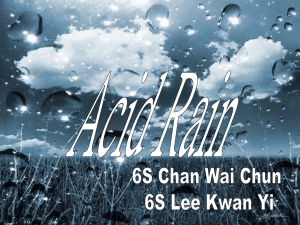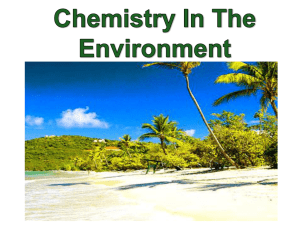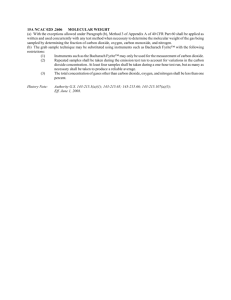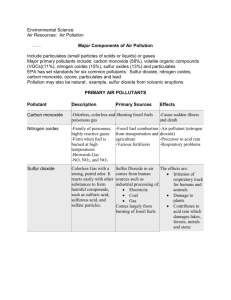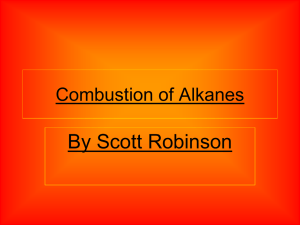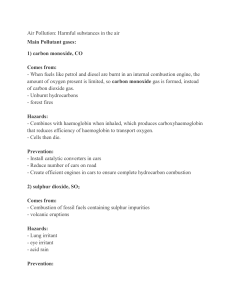IGCSE Chemistry: Air and Water Whole Unit Overview www.XtremePapers.com
advertisement
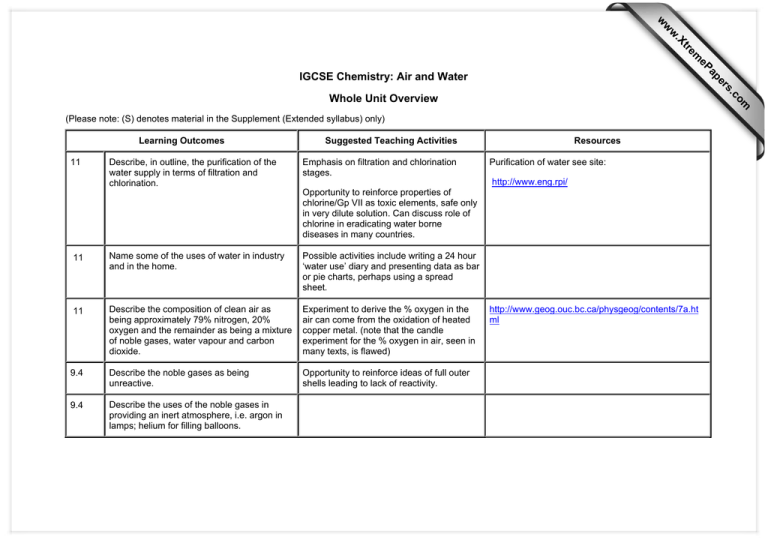
s er ap eP m e tr .X w w w IGCSE Chemistry: Air and Water om .c Whole Unit Overview (Please note: (S) denotes material in the Supplement (Extended syllabus) only) Learning Outcomes 11 Describe, in outline, the purification of the water supply in terms of filtration and chlorination. Suggested Teaching Activities Emphasis on filtration and chlorination stages. Resources Purification of water see site: http://www.eng.rpi/ Opportunity to reinforce properties of chlorine/Gp VII as toxic elements, safe only in very dilute solution. Can discuss role of chlorine in eradicating water borne diseases in many countries. 11 Name some of the uses of water in industry and in the home. Possible activities include writing a 24 hour ‘water use’ diary and presenting data as bar or pie charts, perhaps using a spread sheet. 11 Describe the composition of clean air as being approximately 79% nitrogen, 20% oxygen and the remainder as being a mixture of noble gases, water vapour and carbon dioxide. Experiment to derive the % oxygen in the air can come from the oxidation of heated copper metal. (note that the candle experiment for the % oxygen in air, seen in many texts, is flawed) 9.4 Describe the noble gases as being unreactive. Opportunity to reinforce ideas of full outer shells leading to lack of reactivity. 9.4 Describe the uses of the noble gases in providing an inert atmosphere, i.e. argon in lamps; helium for filling balloons. http://www.geog.ouc.bc.ca/physgeog/contents/7a.ht ml 11 Name the common pollutants in the air as being carbon monoxide, sulphur dioxide, oxides of nitrogen and lead compounds. Oxides of nitrogen see air pollution in site: http://www.doh.gov.uk/ Sulphur dioxide see air pollution in site: http://www.doh.gov.uk/ Carbon monoxide see air pollution in site: http://www.doh.gov.uk/ 11 State the source of each of these pollutants: carbon monoxide from the incomplete combustion of carbon-containing substances Opportunity for data analysis of tables of air quality data. Lead in petrol: http://www.mcl.tulane.edu/ Possible issues for discussion include sulphur dioxide from the combustion of fossil fuels which contain sulphur compounds (leading to ‘acid rain’) • reliance on fossil fuels (petrol, power stations) as a major contributory factor in nature of air pollution • the reduction in use of leaded petrol as a ‘success story’ driven by many governments subsidising unleaded petrol. oxides of nitrogen and lead compounds from car exhausts. 11 (S) Describe and explain the presence of oxides of nitrogen in car exhausts and their catalytic removal. Links with transition metals. Emphasis on the formation of nitrogen, water and carbon dioxide. Links to other units include the opportunity for treatment of converter reactions in terms of redox (section 7.3, Unit 8 Elecrochemistry). Reinforcement of catalytic chemistry (section 7.1 Unit 5 Chemical Analysis) and transition metal use (section 10.3(b) Unit 1 Periodic Table 1). http://www.tnrcc.state.tx.us/air/monops/lessons/leadi nfo.html 11 State the adverse effect of common pollutants on buildings and on health. Emphasis on limestone decay, rusting of iron and tarnishing of copper.This provides an opportunity for students to carry out group research, perhaps presenting their findings to the rest of the class using overhead projection foils or posters. Each group can research the effects of a different pollutant gas in terms of how it is produced, its adverse effects and methods for solving the problem. Issues include: • Acid rain effects on vegetation, aquatic life. • Nitrogen dioxide and sulphur dioxide as respiratory irritants. • Dangers of CO poisoning from cars and poorly maintained domestic heaters. • Reasons for high concentration of pollutants in cities and subsequent effects on health. The role of chemistry in a ‘search for solutions’ can also be discussed e.g. • attempts to control the effects of sulphur emissions (scrubbers) • liming of lakes and soil to neutralise some of the effects of acid rain • development of alternative fuels, catalysts to lower energy use in industry and catalytic converters for cars. 11 (S) Describe the separation of oxygen and nitrogen from liquid air by fractional distillation. 11 Name the uses of oxygen in oxygen tents in hospitals and with acetylene (a hydrocarbon) in welding. 11 Describe methods of rust prevention: paint and other coatings to exclude oxygen. Link this to boiling points and the fractional distillation of petroleum and ethanol. Experiment involving the investigation of rusting of iron nails using these methods. http://www.mynewschool.co.uk/chemistry-r.htm (site for sales of equipment) 11 (S) Describe methods of rust prevention: galvanising. 11 (S) Describe sacrificial protection in terms of the reactivity series of metals. Opportunity to reinforce reactivity series (section 10.2 Unit 1 Periodic Table 1) 11 Describe the formation of carbon dioxide: Investigation of carbon dioxide produced possible using simply limewater. as a product of complete combustion of carbon-containing substances as a product of respiration as a product of the reaction between an acid and a carbonate. Comparison of oxygen and carbon dioxide content in air before and after respiration and combustion. Possible issues to raise include the role of carbon dioxide from combustion of fossil fuels contributing to global warming. (note that the present concentration of CO2 in the atmosphere is 0.038%)


